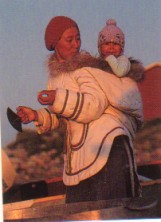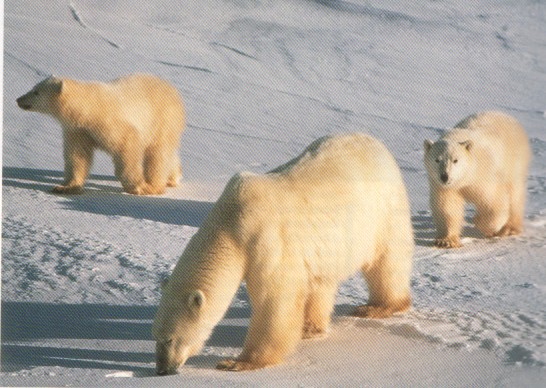|
● Welcome
to Canada/Bien Venu Au Canada
● The
Regions of Canada
● The
North
● The
West
● The
Prairies
● Central Canada
● The
Atlantic Region
● History
● What's in a
Name?
The North
 To
the north, Canada extends up into the Arctic Circle to the North Pole.
The
north is a scarcely populated area of ice and oceans which is sometimes
called "the Land of the Midnight Sun" because during the height
of
summer the sun does not set. Most of the inhabitants
are Aboriginal
peoples
and indeed, several Aboriginal languages have been granted the same official status as French and
English. To
the north, Canada extends up into the Arctic Circle to the North Pole.
The
north is a scarcely populated area of ice and oceans which is sometimes
called "the Land of the Midnight Sun" because during the height
of
summer the sun does not set. Most of the inhabitants
are Aboriginal
peoples
and indeed, several Aboriginal languages have been granted the same official status as French and
English.
 |
| People
Living in a High Arctic Village |
 The
region is currently divided into two huge administrative territories—the
Yukon
and the Northwest Territories—administered mainly by the federal
government. (In 1999, a third territory called Nunavat will be carved
from the eastern part of the Northwest Territories.) The coldest
temperature ever recorded in Canada was in the Yukon, where the
mercury
hit-63 degrees Celisus. The
region is currently divided into two huge administrative territories—the
Yukon
and the Northwest Territories—administered mainly by the federal
government. (In 1999, a third territory called Nunavat will be carved
from the eastern part of the Northwest Territories.) The coldest
temperature ever recorded in Canada was in the Yukon, where the
mercury
hit-63 degrees Celisus.
 Here,
how far the Canada landmass
extends
is technically under dispute,
owing
to international controversies
over
maritime
limits,
that is, how far a nation's sovereignty
extends
over its oceans. Along
the northern border, the coastlines are literally forming, melting
and breaking away and floating
off
in the form of ice floes.
It is difficult to say exactly where Canada begins and ends. But
in this harsh, inhospitable
region, it does not matter very much as no one is actually counter-claiming
what Canada considers its territory—although during the Cold
War, Canada occasionally protested about American nuclear
submarines
patrolling the northernmost ocean regions. Here,
how far the Canada landmass
extends
is technically under dispute,
owing
to international controversies
over
maritime
limits,
that is, how far a nation's sovereignty
extends
over its oceans. Along
the northern border, the coastlines are literally forming, melting
and breaking away and floating
off
in the form of ice floes.
It is difficult to say exactly where Canada begins and ends. But
in this harsh, inhospitable
region, it does not matter very much as no one is actually counter-claiming
what Canada considers its territory—although during the Cold
War, Canada occasionally protested about American nuclear
submarines
patrolling the northernmost ocean regions.
 |
|
Polar Bear
|
 The
traditional northern economy was based on hunting and trapping animals
for food and pelts,
activities which are still carried out by some of native inhabitants.
In
the late 1800s, thousands of miners poured into the Yukon during
the Gold Rush, hoping to make their fortunes. Nowadays,
the northern economy is developing its oil and gas deposits,
and the Inuit
peoples depend on arts and crafts, as well as hunting, for their
livelihood. The
traditional northern economy was based on hunting and trapping animals
for food and pelts,
activities which are still carried out by some of native inhabitants.
In
the late 1800s, thousands of miners poured into the Yukon during
the Gold Rush, hoping to make their fortunes. Nowadays,
the northern economy is developing its oil and gas deposits,
and the Inuit
peoples depend on arts and crafts, as well as hunting, for their
livelihood.
Previous Page Next
Page
|

